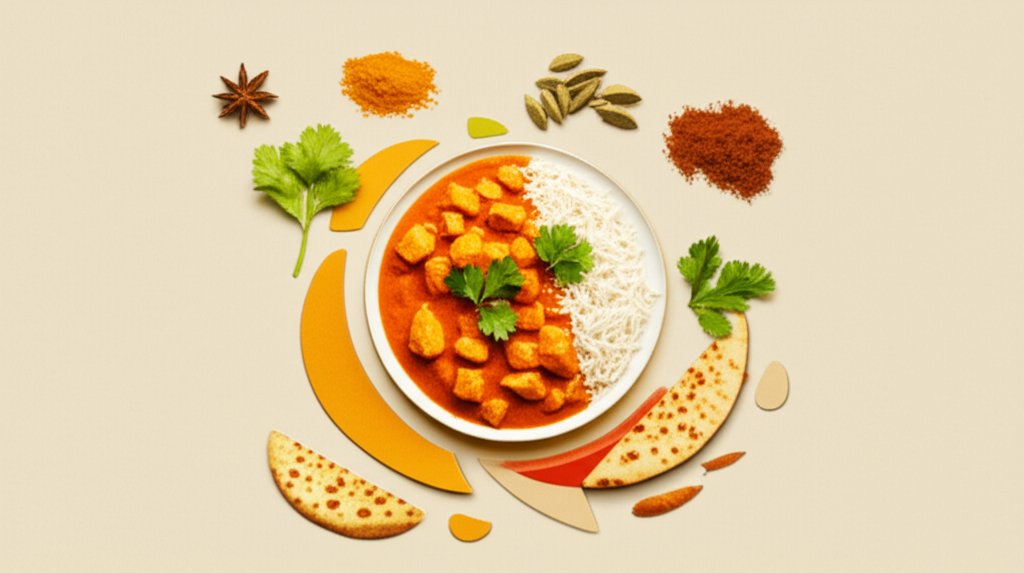Craving chicken tikka masala? You’re not alone. This globally popular dish, with its tender chicken and creamy, spiced tomato sauce, is a favorite for good reason. But have you ever stopped to consider the chicken tikka masala nutrition facts? Understanding what you’re eating is key to enjoying your favorite foods as part of a balanced diet.
Chicken Tikka Masala Nutrition Facts at a Glance:
- Calories: Varies widely (250-700 per serving) depending on ingredients and portion size.
- Protein: A good source, typically around 25-30 grams per serving.
- Fat: Can be high, especially in restaurant versions, due to cream and ghee.
- Sodium: Restaurant versions can be very high in sodium.
- Homemade is Healthier: You have control over ingredients and portion size.
What is Chicken Tikka Masala?
Chicken tikka masala is a dish of marinated and grilled chicken pieces (tikka) simmered in a spiced tomato-based sauce. While its origins are debated, it’s now a staple in Indian restaurants worldwide, though the preparation and ingredients can vary considerably.
The Good Stuff: Nutritional Benefits of Chicken Tikka Masala
Despite potential downsides (more on that later), chicken tikka masala does offer some nutritional benefits:
Protein Powerhouse: Fueling Your Body
Chicken is a champion source of lean protein, essential for muscle growth, repair, and overall health. A typical serving of chicken tikka masala delivers approximately 25–30 grams of protein, helping you meet your daily protein needs.
Vitamin and Mineral Boost
The components of chicken tikka masala contribute more than just protein. A glance at the ingredients reveals a surprisingly nutrient-rich profile.
- Tomatoes: The base of the sauce, tomatoes are packed with vitamin C and lycopene, a powerful antioxidant linked to heart health and reduced inflammation.
- Spices: Turmeric, cumin, and ginger aren’t just for flavor—they’re known for their anti-inflammatory and immune-boosting properties.
- Turmeric: Contains curcumin, which has potential benefits for reducing inflammation and improving brain health.
- Ginger: Aids digestion and has antioxidant effects.
Sustained Energy
Chicken tikka masala includes a mix of macronutrients – proteins, fats, and carbohydrates – providing sustained energy. It’s a hearty, filling dish that can keep you satisfied for longer, reducing the urge to over snack.
Decoding the Chicken Tikka Masala Nutrition Facts: Calorie Count and Macronutrients

Here’s a general breakdown of the chicken tikka masala nutrition facts based on a 1-cup serving (approximately 240 grams):
- Calories: 250–400 (homemade) to 400–700 (restaurant), depending on cream, butter, and chicken cuts.
- Protein: ~25–30 grams.
- Fat: ~10–20 grams.
- Saturated Fat: ~5–8 grams.
- Carbohydrates: ~10–15 grams.
- Sugars: ~5–8 grams.
- Sodium: 400-600mg (homemade) to 800-1200mg (restaurant).
It’s worth noting that these numbers are estimates. The actual nutritional content can vary significantly based on the specific recipe and ingredients.
Potential Pitfalls: Where Chicken Tikka Masala Can Go Wrong
While chicken tikka masala boasts some nutritional advantages, it’s essential to be aware of potential drawbacks. Restaurant versions, in particular, can be surprisingly high in calories, fat, and sodium.
Calorie Creep: Rich Ingredients and Portion Size
Traditional recipes often include heavy cream, butter, or ghee, which can significantly increase the calorie content. Restaurant portions are often oversized too. See Chips Ahoy Nutrition Info
- Restaurant Versions: Often range from 400–700 calories per serving (1.5-2 cups).
- Homemade Versions: Can be lighter, but still average 250–400 calories depending on preparation.
Saturated Fat Overload
The use of cream and ghee contributes to higher levels of saturated fat, which can impact heart health if consumed in excess.
- Typical Amount: ~5–8 grams of saturated fat per serving.
- Healthier Substitutes: Low-fat yogurt or light coconut milk can reduce saturated fat content.
Sodium Bomb
Restaurant versions often contain a shocking amount of sodium.
- Restaurant Versions: Can contain up to 1,200 mg of sodium per serving, nearly half the recommended daily limit.
- Homemade Versions: Average around 400–600 mg per serving, depending on added salt and ingredients.
- Health Tip: Reduce sodium by controlling added salt and using fresh, unprocessed ingredients.
Hidden Sugars
While the natural sweetness of tomatoes is welcome, some recipes add sugar, boosting the carbohydrate content.
- Average Sugar Content: ~5–8 grams per serving, depending on the recipe.
- Health Tip: Skip added sugar and rely on natural sweetness from tomatoes and spices.
Restaurant vs. Homemade: A Nutritional Showdown
The chicken tikka masala nutrition facts can vary dramatically depending on whether you order it at a restaurant or make it at home. Here’s a side-by-side comparison:
| Aspect | Restaurant Version | Homemade Version |
|---|---|---|
| Calories | 400–700 | 250–400 |
| Protein | 25–30 grams | 25–30 grams |
| Fat | 20–30 grams | 10–15 grams |
| Sodium | 800–1,200 mg | 400–600 mg |
| Portion Size | 1.5–2 cups | 1 cup |
| While restaurant versions offer convenience and potentially richer flavor, homemade chicken tikka masala empowers you with better nutritional control. By preparing it yourself, you can enjoy the same delicious flavors with healthier choices, making it suitable for a variety of dietary needs. You can also easily adapt your cooking to different diet plans such as keto. Check out Chorizos Nutritional Value Explored for more information on how to plan your personalized dietary needs! |
Smart Swaps: Healthier Ways to Enjoy Chicken Tikka Masala

Want to enjoy chicken tikka masala without the nutritional guilt? Here are some tips for making smarter choices:
- Portion Control is Key: Stick to a 1-cup serving size to manage calorie intake. Oversized portions can easily make this dish more calorie-dense than expected, particularly when paired with high-calorie sides like naan or rice.
- Choose Lean Protein: Opt for chicken breast instead of thigh meat to reduce fat content.
- Lighten the Sauce: Use low-fat yogurt or light coconut milk instead of heavy cream.
- Grill or Broil the Chicken: Cooking the chicken on a grill or under a broiler gives it a smoky flavor with minimal added fat.
- Watch the Sodium: Use fresh spices and tomatoes to control sodium levels. Avoid pre-made sauces or spice mixes, which often contain hidden salt.
- Skip the Sugar: Omit added sugar and let the natural sweetness of the tomatoes shine.
- Load Up on Veggies: Add extra vegetables like bell peppers, onions, or spinach to boost the nutritional value and fiber content.
A Simple, Healthier Chicken Tikka Masala Recipe
Here’s a basic recipe you can adapt to your liking.
Ingredients:
- 1 lb skinless, boneless chicken breast
- 1 cup plain low-fat yogurt (for marinade)
- 1 can (14 oz) crushed tomatoes
- 1/4 cup light coconut milk or almond milk
- 2 tsp olive oil
- Spices: 1 tsp turmeric, 1 tsp garam masala, 1 tsp cumin, 1/2 tsp cayenne
Instructions:
- Marinate chicken in yogurt and spices for 30 minutes.
- Grill or broil chicken until lightly charred.
- In a pan, sauté spices with olive oil, then add crushed tomatoes and simmer for 10 minutes.
- Stir in coconut milk, add grilled chicken, and cook for another 5 minutes.
Calories Per Serving (1 Cup): ~250–300 calories
Common Questions About Chicken Tikka Masala Nutrition Facts
Is chicken tikka masala healthy?
Chicken tikka masala can be part of a healthy diet when made with lean protein, fresh ingredients, and minimal added fats. Homemade versions are typically healthier, offering control over sodium, fat, and calorie content.
What are the main nutrients in chicken tikka masala?
Chicken tikka masala is rich in:
- Protein: ~25–30 grams per serving, supporting muscle repair and growth.
- Vitamins: Vitamin A and C from tomatoes and spices.
- Minerals: Iron and calcium, contributing to blood health and bone strength.
Can I make chicken tikka masala keto-friendly?
Yes!
- Use full-fat yogurt or heavy cream for the sauce.
- Skip high-carb sides like rice or naan, and serve with cauliflower rice or steamed vegetables.
- Avoid sugar or sweeteners in the recipe.
How does chicken tikka masala compare to butter chicken?
- Butter Chicken: Creamier and sweeter, with more butter and cream.
- Chicken Tikka Masala: Spicier and tangier, with a tomato-forward flavor.
Butter chicken is generally higher in calories due to richer ingredients.
Can I freeze chicken tikka masala?
Yes! Chicken tikka masala freezes well for up to 3 months:
- Store in an airtight container.
- Reheat gently on the stovetop to preserve texture and flavor.
Making Informed Choices: Enjoying Chicken Tikka Masala Mindfully
Chicken tikka masala is a beloved dish that offers a delicious balance of spices, creamy textures, and satisfying protein. By understanding the chicken tikka masala nutrition facts and making informed choices about ingredients and portion sizes, you can confidently indulge in this flavorful dish as part of a balanced and healthy lifestyle. By making informed choices about what you eat, you can fully enjoy all the things you love!
- Plastic Bento Boxes Face Scrutiny Over Sustainability Impacts - December 11, 2025
- Bento Tray Revolutionizes Organized Meal Transport and Presentation - December 10, 2025
- Meal Plans for Busy Schedules That Make Healthy Eating Easy - December 10, 2025










